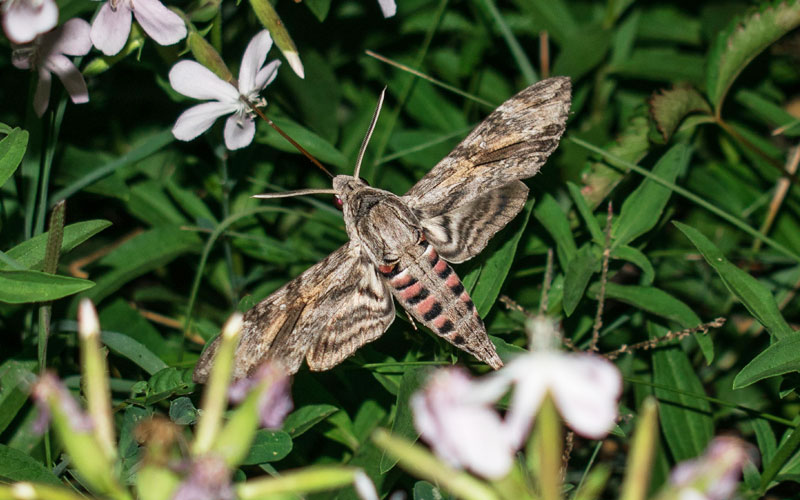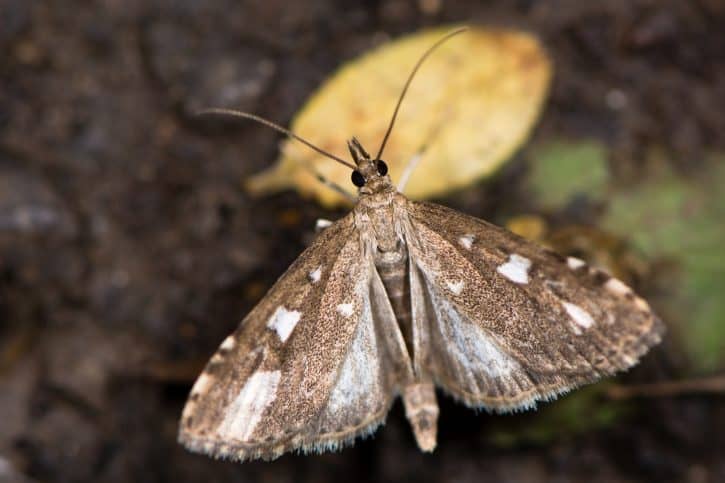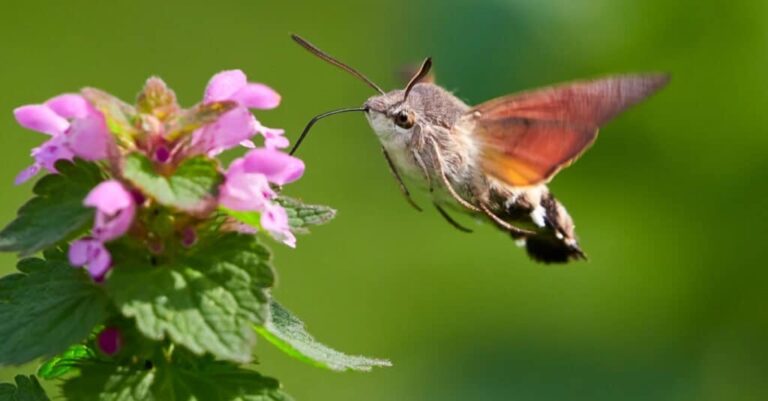Moths have two main stages in their life cycle with different dietary habits. Adult moths primarily focus on mating and do not eat much, if at all. Moth larvae, or caterpillars, are in the feeding stage. They consume various plant materials, such as leaves, fruits, and flowers, depending on their species.
Some caterpillars are specialized, while others are generalist feeders. Caterpillars also obtain moisture from the plants they eat and do not typically drink water separately. Moth diets vary among species, with some being pests that damage crops, while others have essential roles in pollination and ecosystems.
How does the moth life cycle work?
The life cycle of a moth is characterized by a series of developmental stages, each with its own distinct characteristics and behaviors. Understanding this life cycle is crucial to comprehending the dietary habits of moths.
The moth life cycle begins when a female moth lays eggs, often on or near suitable food sources for the emerging caterpillars. The eggs vary in appearance and size depending on the moth species.
After hatching from the eggs, moths enter the larval stage as caterpillars. This is the primary feeding and growth phase of their life cycle. Caterpillars undergo multiple molts, shedding their exoskeletons as they grow.
At a certain point in their development, caterpillars enter the pupal stage, during which they undergo metamorphosis. Inside the pupa, they undergo significant changes, transforming into adult moths.
Once the metamorphosis is complete, adult moths emerge from the pupa. Adult moths are often characterized by their wings, and they have reproductive organs but do not feed as their primary goal is to reproduce.
Differences in Dietary Habits between Adult Moths and Caterpillars:

| Aspect | Adult Moths | Moth Larvae (Caterpillars) |
| Reproductive Focus | Main objective is reproduction and egg laying. | Primary feeding stage. |
| Invest most energy/resources in mating. | ||
| Limited lifespan (a few weeks to days). | Feeding supports rapid growth. | |
| Feeding Behavior | Limited feeding, often minimal. | Specialized mouthparts (mandibles) for chewing. |
| May consume small amounts of nectar. | Diverse diets depending on species. | |
| Consume large quantities of food. | ||
| Energy Utilization | Rely on energy reserves from the caterpillar stage. | Food provides energy for metamorphosis. |
What do adult moths primarily eat?
The primary focus of adult moths, upon emerging from the pupal stage, is mating and reproduction. This phase is critical to the continuation of the moth species.
Adult moths often have a limited lifespan, which varies greatly among species but is typically short, ranging from a few days to a few weeks. This short time frame is primarily devoted to reproductive activities.
Adult moths engage in intricate mating rituals, which can involve the release of pheromones by females to attract males. These pheromones are chemical signals that help moths locate potential mates over long distances, sometimes even miles away.
Male moths are highly sensitive to these pheromones and use specialized sensory structures, such as antennae or scent receptors, to detect and follow them. The successful location and courtship of a mate are crucial for the survival of the species.
Explanation That Adult Moths Do Not Eat Much, If at All
One of the notable characteristics of adult moths is their limited or complete lack of feeding behavior. This dietary behavior differs significantly from that of caterpillars, which are voracious plant consumers.
Adult moths typically have mouthparts that are not adapted for chewing and consuming solid food. Instead, their mouthparts may be vestigial or reduced in size and functionality.
Moreover, some adult moths may have rudimentary mouthparts that allow for minimal feeding, but the amounts consumed are generally insufficient to sustain them for an extended period.
Furthermore, this lack of significant feeding is due to their focus on reproduction. Adult moths prioritize conserving energy for mating, searching for suitable egg-laying sites, and ensuring the continuation of their species.
The Possibility of Some Adult Moths Consuming Small Amounts of Nectar or Other Liquids for Energy
While most adult moths do not engage in substantial feeding, there are exceptions. Some adult moths have adapted to consume small amounts of liquids for energy.
Certain moth species, such as hawkmoths or sphinx moths, are known to visit flowers at night to feed on nectar. They have specialized mouthparts that allow them to access and sip nectar from flowers.
In addition to nectar, some adult moths may consume other liquids, such as tree sap, fruit juices, or rotting fruit juices, if these resources are available.
Liquid consumption by these moths is typically a supplementary behavior and may occur intermittently to support their energy needs during their short adult lives.
How do caterpillars feed and grow?
Caterpillars are the second developmental stage in the life cycle of moths, following the egg stage. They are the primary feeding stage and serve as the larval form of moths.
Caterpillars are typically characterized by their segmented bodies, numerous legs, and specialized mouthparts, which are adapted for chewing and consuming plant material. Moreover, their primary function during this stage is to feed voraciously to support their growth and development.
Caterpillars have specialized mouthparts known as mandibles. These mandibles are strong, tooth-like structures that are well-suited for cutting and grinding plant material.
Unlike adult moths, which often have reduced or non-functional mouthparts, caterpillars have robust and efficient mandibles that allow them to process a wide variety of plant matter.
Caterpillars use their mandibles to tear and chew leaves, stems, and other plant parts into smaller pieces, which are then digested and assimilated to support their rapid growth.
Caterpillars exhibit a remarkable diversity in their dietary preferences, with different species adapted to various ecological niches and food sources.
Some caterpillars are highly specialized and feed exclusively on specific plant species or families. For example, the monarch butterfly caterpillar primarily consumes milkweed leaves.
Generalist feeders, on the other hand, have a broader diet and may consume a wide range of plant materials, including leaves, flowers, fruits, and even wood.
Some wood-boring moth caterpillars tunnel into and feed on the wood of trees, which can have ecological and economic implications.
A unique example is the silkworm (Bombyx mori) caterpillar, which feeds exclusively on mulberry leaves to produce silk.
The Role of Caterpillars in Obtaining Moisture from the Plants They Eat
Caterpillars not only obtain their nutrients from the plant material they consume but also acquire moisture from their food.
Plants typically contain water, and caterpillars extract this moisture as they feed. This helps caterpillars meet their hydration needs, and they do not usually require separate sources of drinking water.
Caterpillars are efficient in utilizing both the nutrients and moisture from their diet to support their growth and development, including the production of energy reserves needed for the pupal stage.
What determines the diets of different moth species?

Moths represent a highly diverse group of insects, with over 160,000 described species worldwide. This diversity is reflected in their diets, which can vary significantly among species.
Moth species have evolved and adapted to thrive in different ecological niches, which often correspond to specific food sources. This adaptability allows them to exploit a wide range of habitats.
Some moth species are highly specialized in their dietary preferences, feeding exclusively on certain plant species or parts. Others are generalists, with diets that encompass a broader spectrum of plant materials.
The yucca moth (Tegeticula) is a specialized pollinator that exclusively feeds on yucca plants. Its life cycle is intricately tied to the yucca’s reproductive cycle.
Distinction Between Pest Moths That Damage Crops and Moths
| Aspect | Pest Moths | Pollinator Moths |
| Role in Ecosystems | Can be detrimental as agricultural pests, causing economic losses. | Vital for plant pollination, aiding in reproduction. |
| Examples | Corn earworm (Helicoverpa zea), cabbage moth (Mamestra brassicae). | Various moth species, both diurnal and nocturnal. |
| Feeding Behavior | Caterpillar stages consume crops, posing a threat to agriculture. | Feed on nectar and inadvertently transfer pollen while visiting flowers. |
| Ecological Role | May disrupt agricultural systems and require pest management. | Contribute to plant reproduction and support ecosystem biodiversity. |
| Importance in Ecosystems | Considered problematic in some contexts due to crop damage. | Serve as important pollinators and maintain ecological balance. |
| Indicator of Ecosystem Health | Their presence can indicate the need for pest control measures. | Presence can indicate a healthy ecosystem. |
| Conservation Importance | Management strategies often involve control or eradication. | Preservation of diversity is vital for pollination services and biodiversity. |
FAQ’s
What do newborn moths eat?
Newborn moths typically do not eat; their primary focus is finding a suitable place to pupate and complete their metamorphosis.
What materials do moths eat?
Moths primarily feed on plant materials, such as leaves, flowers, and occasionally fruits. Some moth caterpillars may also feed on wood or detritus.
How do you save a moth?
To save a moth indoors, gently catch it with your hand or a container and release it outside. Avoid touching their wings, as they are delicate.
Are moths attracted to sugar water?
Some moths, particularly those that feed on nectar, may be attracted to sugar water if it’s offered as a food source.
What kills moths?
Moths can be killed by natural predators like birds, spiders, and parasitoid wasps. They can also be controlled through pesticides if they are considered pests.
Do moths eat flour?
Some moth species, like the Indian meal moth, may infest stored food products like flour, but not all moths eat flour.
Will moths eat clothes?
Moths themselves do not eat clothes; it’s their larvae (caterpillars) that may damage natural fibers like wool and silk by feeding on them.
Final Words
The conclusion of the discussion on moths encapsulates their multifaceted role in ecosystems and underscores their importance in the natural world. Moths, despite being often overlooked, are integral components of ecosystems worldwide. Their diverse dietary habits, ranging from pollination to nutrient cycling, highlight their significance in maintaining ecological balance.
Moreover, moths serve as vital links in food webs, providing sustenance to a variety of predators. Recognizing their value not only as pollinators but also as indicators of environmental health is critical for conservation efforts.
By safeguarding moth diversity, we not only preserve their intrinsic worth but also contribute to the overall health and stability of ecosystems. In conclusion, moths, with their varied ecological roles, are emblematic of the intricate interconnectedness of life in our natural world, and their conservation deserves our attention and care.


I just added this feed to my bookmarks. I have to say, I really enjoy reading your blogs. Thanks!
Interesting post. Certain that My partner and i’ll keep coming back here. Good work.
Remarkable post! Chatting about how taken pleasure in the exact examining. I’m hoping to see significantly more from your website. It looks you might have very good knowledge combined with perception. My corporation is very much fulfilled with this particular tips.
Superb brief which post helped me a lot. Say thank you We seeking your information?–.
I discovered your blog post website online and check a number of your early posts. Always maintain up the great operate. I recently extra your Feed to my MSN News Reader. Seeking forward to reading a lot more from you finding out afterwards!…
As I website possessor I think the subject matter here is real wonderful, appreciate it for your efforts.